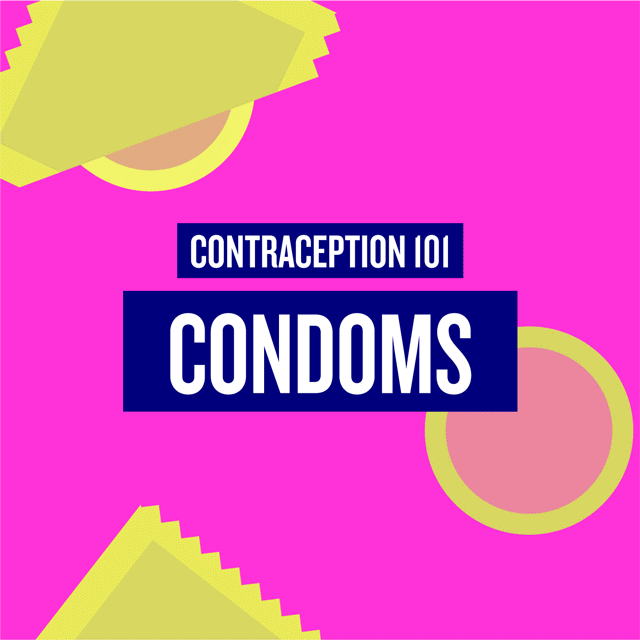The pull-out method. Sex standing up. The crisp packet condom. Jumping up and down after sex. These are all not methods of safe contraception.
We’ve got a guide on everything that is...
Choosing the right contraception to suit your lifestyle is a really important decision if you’re sexually active. Some involve hormones, some are natural, some are temporary and others more of a commitment. Either way, if you’re not ready for a bun in your oven, you’ll need to take responsibility and figure out the best method of contraception for you.

Condoms
Let’s get the obvious out of the way first. Out of all of the methods available, condoms are the only thing that will protect you against STIs as well as pregnancy. So unless you’re in it for the long haul or in a long term trusting relationship and you’ve both been tested, condoms are pretty essential. We’ll also include femidoms in this category, which are an option for some, and great if you want to be in control of your own contraception, however since their launch in the UK in 1993 they’ve been famously unpopular for their distracting noises and failure rate of 21%.
Pros
Feeling safe in the knowledge that you don’t have to deal with the health risks or the emotional stress of getting an STI. It’s not just the bloke who needs to carry condoms, you can slip some in your handbag or purse so you’re in control of having safe sex too.
Feeling safe in the knowledge that you don’t have to deal with the health risks or the emotional stress of getting an STI. It’s not just the bloke who needs to carry condoms, you can slip some in your handbag or purse so you’re in control of having safe sex too.
Cons
Beware of oil based lubricants! They can dissolve the johnny rendering it totally useless, so stick to water based if you’re using condoms! Vigorous sex (oi oi) may also lead to a condom splitting- this is rare and unlucky. If this happens to you, think about a back-up plan like also going on the pill.
Beware of oil based lubricants! They can dissolve the johnny rendering it totally useless, so stick to water based if you’re using condoms! Vigorous sex (oi oi) may also lead to a condom splitting- this is rare and unlucky. If this happens to you, think about a back-up plan like also going on the pill.

The Combined Pill
The combined pill works by preventing your ovaries from releasing an egg each month. It thickens the mucus in the neck of the womb, so it is harder for sperm to penetrate it and it thins the lining of the womb, so there is less chance of a fertilised egg being implanted. Usually, the pack contains 21 pills which you take back to back, then have a 7 day break which is when you bleed.
Pros
If you have heavy periods or painful periods, PMS or endometriosis the combined pill may help. It’s convenient to know when exactly you’ll have your period, so you can plan your life around it. It’s over 99% effective if used correctly. Research also suggests that using the pill can help with acne.
Cons
It can be hard to remember to take it at the same time everyday, which is a must. If you miss a pill, vomit, have severe diarrhoea (or even a tea tox in some cases) it won’t work, so you’ll have to use condoms for a week afterwards if this happens. Minor side effects include mood swings, nausea, breast tenderness and headaches. It doesn’t protect against STIs, so you’ll also need to use a condom too. You shouldn’t take this pill if you’re a heavy smoker or over 35.

The Progestegen Only Pill (POP)
This works the same way as the combined pill, by thickening the mucus of the womb and preventing sperm from swimming into it. Unlike the combined pill, you take it everyday with no breaks.Pros
The POP contains the hormone progestogen, but don’t contain oestrogen, so it’s useful if you can’t take the hormone which is in the combined pill, contraceptive patch and vaginal ring. You can use it at any age – even if you smoke and are over 35
Cons
You must take it within a 3 hour window of the same time everyday, which can be difficult to remember to do. It drops down to only being 90% effective so if you’re scatty this may not be for you. Using alarms or reminders on your phone will help with this though. Some women have reported they don’t get regular periods while taking it so be prepared for a change in flow. This could be anything from lighter to more frequent, to stopping all together or spotting between periods - it’s a bit of a gamble and depends on your body.

The Patch, Implant, Injection, And Vaginal Ring
These are all hormonal methods (like the combined pill). They all release hormones into the bloodstream (or through the skin with the patch) to prevent ovulation. Pros
Because these are non oral medicines, having diarrhoea or vomiting won’t prevent them from working. They are usually used for longer periods of time, so you don’t have to think about them everyday. Discuss with your GP which one works for you.
Cons
These methods don’t protect against STIs, so you’ll also need to use a condom.

The IUD or 'Coil'
An IUD is a small, T-shaped plastic and copper device that’s put into your womb by a doctor or nurse. It releases copper to stop you getting pregnant. It’s sometimes called a “coil” or “copper coil”. Pros
It’s effective for between 5 and 10 years, so it’s a great long-term option. If you’re too forgetful for the Pill then it may work well for you.
Cons
Getting it fitted can be uncomfortable, but painkillers will help. Some women notice their periods can be heavier, longer or more painful in the first 3 to 6 months after an IUD is put in, and there might be spotting or bleeding between periods.

The Cap And The Diaphragm
Slightly old-school (your mum probably definitely used these), a contraceptive diaphragm or cap is a circular dome made of thin, soft silicone that’s inserted into the vagina before sex. It covers the cervix so sperm can’t get into the womb (uterus) to fertilise an egg. Pros
Non-hormonal, just like condoms. Success is up there at 92-96%
Cons
You’ve got to remember to insert the cap or the diaphragm each and every time you have sex, so it takes a bit of self-discipline and planning. They don’t protect against STIs, so you’ll need to use condoms with new partners.
Ovulation Tracking
There are some apps out there which use a thermometer and period tracking, and each morning give you either a green light for go or a red light for no as to whether you are fertile or not that day. Popular app Natural Cycles uses your basal body temperatures (BBT) each morning and records them within the mobile app. It monitors changes in BBT to estimate when you will ovulate. Pros
A great option if you’re concerned about putting hormones into your body. Perhaps you’ve been on the Pill for a few years and fancy a break?
Cons
Beware and do your research, due to potential human error and the guesswork that the app does, on average, fertility awareness-based methods of contraception are only 76 percent effective.

Female Sterilisation
A more extreme and long term option, this is basically the female vasectomy, in which the fallopian tubes are clipped to seal them. This is a permanent method with no serious side effects. Pros
It’s available on the NHS and the success rate is almost 100%, and if having kids is definitely off the menu for you, it takes all the risk out of getting pregnant. Now you only have to worry about STI’s with new partners...
Cons
There’s a small risk of ectopic pregnancy and the surgical procedure has a failure rate of 1%.

Emergency Contraception
Whether the condom split, you got carried away in the heat of the moment (we’ve been there) or something happened that was out of your control - emergency contraception, more commonly known as the morning after pill, is available. Get yourself to the chemist as soon as you can and take a single pill to prevent pregnancy. Take it ASAP, but if you can’t, don’t leave it longer than 3 days. Pros
This is a convenient and discreet emergency option with a very high success rate. Most pharmacies will do it for free.
Cons
Research shows that there are no known bad effects from taking this, however using it often is certainly not good for you. If you’ve had to take it more than 3 times in the last year, consider organising yourself with some of the contraception methods mentioned above.





